Menus
- Face to face with the 2016 DCT and ABS trail versus the 2001 vintage
- Saga Africa
- Discovery
- DCT robotic box
- In the saddle
- In the city
- Motorway and expressways
- Departmental
- All Terrain
- Cycle part
- Braking
- Comfort / Duo
- Consumption
- To watch on the XRV750 model
- Conclusion
Face to face with the 2016 DCT and ABS trail versus the 2001 vintage
Saga Africa
As a reminder, the origin of the Africa Twin is a prototype, the NXR 750, designed for rallies. Appeared in 1986, he then won the Paris Dakar. Two years later, the XRV 650 Africa Twin is offered to the public. Motorized by a V-Twin, its versatile cycle part allows real offroad outings. Evolving in CRV 750 (+100 cm3 and double front discs) in 1990, then XRV 750, the desert girl disappeared in 2003. Following her, Honda offered the XL 1000 Varadero. Much sportier with its block from the sporty VTR 1000, it brings the family into road maxi-trails. Less suitable for all terrain, but more efficient on asphalt. An evolution that the VFR 1200 X Crosstourer has completed to design, with its 130 horsepower V4 engine, an optional DCT robotic gearbox and a weight of…. 285 kilos. In contrast, we will recall the XLV750R, novelty of 1982, with its V-twin at 45 ° and transmission…. by gimbal. During our test, we had the chance to take a family photo.
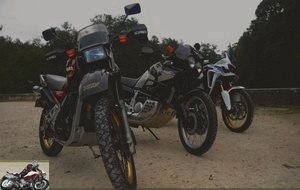
Fortunately, the Africa family has managed to regenerate into a remarkable adventurer. With his successful comeback at the start of 2016, the legend Africa Twin is back on track and its place as a true versatile and efficient trail runner. However, the ancestor continues to inspire bikers eager to acquire, at a good price, a part of the myth. Because if the novelty is acclaimed everywhere, the reputation of "indestructibility" of the original makes it, even today, a machine sought at the high price. In homage to this predecessor, we offer here a "confrontation" between the two generations to judge the evolution of the star wader.
Discovery
Our test copy is a 2001 machine, the latest evolution of the XRV model (1996-2003), in a rare condition, close to new. Of course, over the years, its owner has given it some improvements. High Secdem screen, Rugged Roads crash bars, central stand (optional then) and even specific U-shaped lock, Honda origin, sold as an accessory to fit in the topcase support. Finally, Hyperpro fork springs, braided hoses and Super Sprox aluminum crown have come to optimize the general behavior..
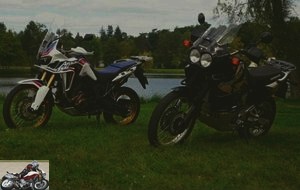
Design question, the old model obviously lost several lengths. At the time, the Africa Twin wanted to be an efficient tool with a style modeled on the rally machine. The period brochure also sets the tone and emphasizes the performance and equipment devolved to offroad. More than 25 years after its conception, the original version certainly betrays a style that is now obsolete, but retains this adventurous spirit. Reinforced fork, but not adjustable, with bellows hiding the plunger tubes, imposing engine guard, one-piece saddle, enduro handlebars and 21-inch spoked front wheel…. beauty imposes an aesthetic and an adventurous stature. Likewise, its broad shoulders hide a reservoir of…. 23 liters. Finally, the Japanese camel has a typical circular double optic. But the trail of the raid years also knew how to welcome the crew, with passenger footrests sheathed in rubber and placed low. On the stern, an aluminum frame incorporating large handles forms a large luggage rack. The whole overhangs ample fairings concealing the rear buckle supports.
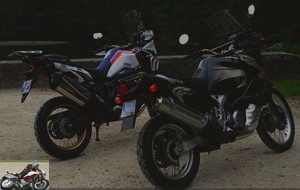
The heiress was able to draw inspiration from her eldest with accuracy and efficiency, but sports a much more dynamic aesthetic, where sport and current performance are reflected in each line. Narrow, compact, the front face has been greatly refined, from the high curved screen (optional) to the scoops. However, although modernized, the essential stylistic codes are there. There are therefore two LED lights with tapered designs, integrated on a fork crown with more protective curves and framed by air intakes. Metal shoe and 21-inch front wheel are renewed. But it is now an adjustable inverted fork that supports the front axle. Ground clearance and suspension travel are even greater. As for the container, it has a capacity of 18.8 liters. Two large seats now accommodate the crew and the rear hull incorporates the supports for suitcases. More ergonomic, the handles of the accompanying person still unite in a practical load support. Refined, the rear loop now rises more towards the heavens on its tubular steel trellis.
The engine and cycle part evolutions are even sharper between the two generations. The XRV750 rested on a steel single-cradle frame, supporting its 742cc V-twin open at 52 °. Fueled by carburettors, with a single ACT controlling 6 valves and a bore / stroke ratio of 80×72 mm, the unit delivers 57 hp at 7,500 rpm and 6.2 da.Nm of torque at 6,000 revolutions / minute. According to the standards, the power has varied, with a maximum of 61 steam cannons. Finally, the gearbox is five-speed.
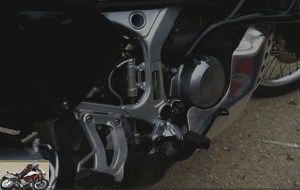
The novelty does not find this genetics, benefiting from the latest technological mutations. Thus, the steel frame of the CRF1000L has a mixed structure, made up of different sections in order to combine rigidity and studied flex zones. The front part is a simple split cradle interrupting under the engine. Two rectangular section elements then surround the block, widening into perforated plates on the rear of the engine. A brand new vertical twin of 998 cm3 now powers the Honda trail. With its small size and ideal weight distribution, the choice of a vertical twin is judicious. Especially since its crankshaft, set at 270 °, causes irregular ignition and delivers V-twin driving sensations. The eight valves are driven, as on the CRF 450 R and 250 R, by a Unicam system. Hyper compact, the Africa Twin’s parallel boiler delivers 94 hp at 7,500 rpm and a torque of 9.8 da.Nm at 6,000 rpm…. Performance far superior to that of its eldest.
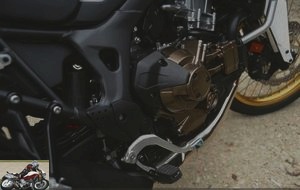
The quiet breath of the Africa 750 like the much sportier one of its descendant, flows into a silencer in the upper right side position. The novelty benefits from a more elaborate styling element, displaying two distinct outputs. You will find all the technical details in the test of the CRF1000L Africa Twin.
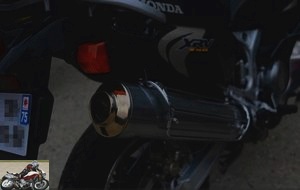
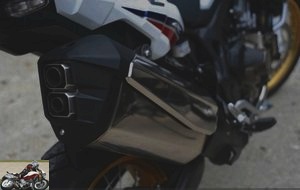
Conventional 43 mm fork and shock absorber adjustable in preload and rebound make up the suspensions of the XRV750. To stop the 21 and 17 inch wheels of the "old", two double picton calipers on the front axle pinch 276 mm discs; in contrast, a single piston element clamps a 256mm fret. Otherwise more modern, the cycle part of the last born is based on a Showa inverted fork with 45 mm cartridge, adjustable in any direction. A shock absorber, of the same origin and adjustment, of the Pro-Link type with separate reservoir manages the swingarm. The braking equipment of the 21 and 18 inch wheels is also at the latest standard of its kind. Two radial-mounted 4-piston calipers drive 310mm discs up front. The rear retarder, single piston caliper, bites a 256mm disc. The ABS watches over the whole and can be disconnected on the rear wheel to promote enduro. Ditto for the traction control at three levels of implementation. Finally, a parking brake equips the DCT-ABS version that we are riding.
Between the two members of the Africa family, the general refinement of the youngest is evident, both in the choice of materials and the quality of finish and equipment. Only little more of the old one: the anti-projection flap fixed on the lower triple tree of the fork which the CRF is deprived of…. Yet very correct for the time, the presentation of the XRV750 is logically withdrawing from that of its replacement. Engine housings, design of the swinging arm and adjustment of the elements…. Honda lives up to its reputation for high standards.
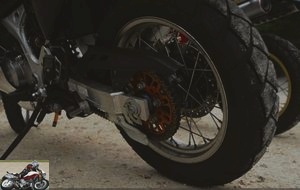
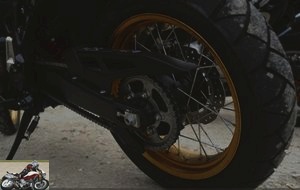
DCT robotic box
The manual transmission CRF1000L has an assisted limited slip clutch. Inclined plates press the clutch discs under stress by weaker springs than usual. Thus, the effort to be produced at the handle is low.
The DCT double-clutch version uses technology dear to Honda. One clutch controls 1/3/5 and the other 2/4/6. Two automatic modes still control the gear changes, D – Drive and S – Sport, but the latter now offers three variables to better follow the needs of the pilot. Finally, a semi-auto mode allows you to control the gearbox yourself. Whatever setting you choose, you keep control of the system at all times. A new G – Gravel mode is added to the device to ensure the best possible performance on soft ground. Likewise, by cross-calculation between the opening angle of the Ride by Wire throttle grip, the gear engaged and the independent rotation measurement of the wheels, the system recognizes a shift up or down, adapting the choice of gear. . The final transmission is provided by chain for weight gain.
The Africa Twins benefit from an engine torque control system HSTC (Honda Selectable Torque Control) with three levels of settings and disconnectable, in order to limit or promote the drifts of the rear wheel.
In the saddle
The 860 mm saddle height of the first Africa of the name did not reassure the less tall. Especially since the width of the front part seems important. The heiress continues the tradition and culminates at 870 mm. But the narrowness of the saddle makes up for this figure. However, you have to lift your leg very high so as not to hit its rear loop, unlike much lower on the 750..
Typed offroad, the wide reinforced handlebars of the XRV are opposed to the variable diameter handlebars of the CRF. The dashboards both admit their age. Mainly analog on the XRV, apart from a few analog windows in the upper element mimicking a raid trip, the cockpit smacks of "before" rallying. Tachometer, tachometer, engine temperature gauge, odometer and two partials form a complete set. All that’s missing is a fuel gauge. The dials are embedded in a thick foam, dominating a sparsely sheathed fork crown revealing a few cables..
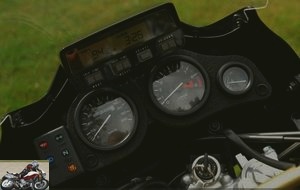
The CRF offers a completely different atmosphere, where all digital governs the CRF’s instruments, integrated into a slightly futuristic console. To the functions of its predecessor, the new Africa adds traction control, gear indicator, average consumption, exterior temperature…. etc. And on our version with DCT gearbox, an additional pusher allows you to engage Gravel mode (off-road clutch adjustment) for a more direct transmission. Other controls directing the selection dress the right commodo. Mode D (Learning Drive) and S (Sport) now with three variables densify the display. So much data unimaginable at the time (not so distant). And all the information is chosen on the handlebars. It’s adventure 2.0.
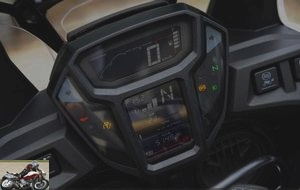
On both machines, the levers are sheltered behind hand guards, reinforced on the novelty, but only the brake lever is adjustable in spacing. Question toolkit, the past is good. To the complete kit of the XRV750, the CRF1000L opposes…. an alen key. But this will allow you to open a box located under the left frame. Little supplied, it has 5 tools.
In the city
In ramage, as in plumage, the new Africa seduces from the start of its twin. Rumbling, its mechanics are very lively. At her side, the eldest child plays a more timid chant by her less alert mobile crew. But the handling of each is the same obvious, as the machines show an excellent balance.
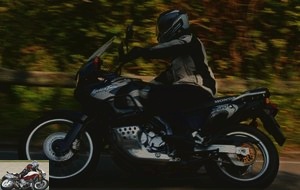
On first braking, the fork’s plunge on the XRV750 would be almost impressive. Such amplitudes are hardly found more than on enduro production. The scale is much better contained on the CRF1000L, improving tight movements in traffic. The general finesse of the latter further reinforces this point. And if the weight of the sisters is almost identical, the distribution of the masses on the news seems to free the modern desert vessel from one part of its masses..

In general, the heiress "necessarily" does everything better than her ancestor, while retaining a welcome, but more or less sensitive parentage. Thus, the two twins show good flexibility at low speed, which the parallel architecture further optimizes. Our version with DCT gearbox provides remarkable pleasure in urban driving. No wonder more than 60% of the machines sold incorporate this technology. Without jerks, the dual-clutch transmission is precise and fast, making you almost forget, in town, an overweight of 10 kilos. And if the maneuvers between the walls are not a problem for them, the two trails still prefer larger spaces..
Motorway and expressways
Like migrating birds, the sisters of the desert are ready to go far and long. But on the XRV750, the vibrations are sensitive from 4,000 rpm. At 130 km / h and 5,000 revolutions, the tingling is very present, both on the handlebars and in the footrests. And its optional high screen generates noise and eddies depending on the size of the pilot…. Capable of a maximum speed of 175 stopwatch, the original Africa can above all, according to its owner, maintain a cruising speed of 150 km / h without flinching..
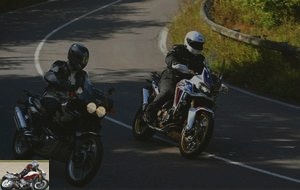
The CRF1000L has greatly improved overall comfort. Its parallel twin purrs at the legal motorway, at 5,500 turns, without unwelcome tremors. With its studied shapes, its high windshield effectively deflects air flows and limits turbulence and sound effects. Capable of peaking at 220 km / h as the breaker approaches, around 8,500 revolutions / minute, the new generation Africa Twin is especially particularly stable at high speed. Perched on very flexible suspensions, the 750 displays a little less rigor. A finding that is also true on the secondary network.
Departmental
The first Africa twin offered measured but exploitable performance, where its successor now places the evolution of its own under welcome electronic supervision. Of course, you can wind up quite quickly on the handlebars of the XRV750, which has a fairly rigid frame and a very good balance. Its 140 mm rear tire gives it good agility in successions of tight curves. However, on angle changes and mass transfers, its suspensions remind the pilot. Especially since the weight is quite high. The 21-inch front wheel is all the more felt, all limiting too pronounced sporting inclinations.
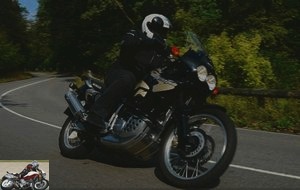
On board the CRF1000L, you can take out the big attack without restraint. Its multicomponent frame and the excellence of its fork attenuate the effect of its cycle part as distinctive as its predecessor. The heiress does not drag at all during changes of angle, its rear envelope showing only 150 mm. Its wide handlebars combine with the footrests to effortlessly guide the wader. Once placed on the side of its tires, it keeps the course perfectly and allows without difficulty the corrections of trajectory. Guidance precision is also one of the great qualities of the new generation..
This imposes a rhythm that the 750 has trouble keeping up with. The 57 horsepower of its V-twin is struggling and requires falling gear, if only to quickly overtake. Vibrant, the former glory of the rally years can only note the quality of evolution of its lineage. Coupler and available at any speed, its replacement delivers ample raises in a muffled and powerful rumble. This dynamic soundtrack contributes to the mechanical pleasure. More discreet, electronic assistance adds security at all times, especially with traction control. Getting out of the curves is therefore more natural. And it is not when braking that the original Africa will return to the 1000. With lower braking power and its plunging fork, it leaves, again, several lengths to its replacement. Indeed, it has a very progressive, remarkably efficient end-of-travel management of the front axle. This allows it to perfectly manage the powerful decelerations delivered by its radial calipers. Finally, well filtered, the vibrations of the parallel unit are hardly noticeable.
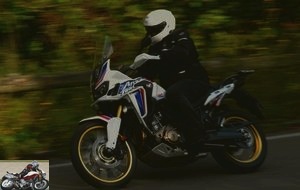
In more relaxed piloting, the two machines are traveling on stilts, enjoying a more coiled rhythm. And here again, the CRF1000L is more attractive, delivering better overall comfort. Our DCT version with double clutch is particularly appreciable. Mode D studies your driving and tries to stick to your wishes. Outside of sporty driving, it actually operates as closely as possible, returning a report if necessary to revive the crew or tackle a bend. However, if you want to tame a little, the choice of level three Sport mode then almost allows you to find a manual gearbox behavior. The efficiency is as astonishing as it is addictive, the gears engaging without any jerks or delays. You can also force the choice of gears using the paddles on the handlebars or switch to manual mode
All Terrain
A quick passage on a rough forest path testifies to the ability of the Africans to get out of the asphalt. Everything is more natural on the CRF1000L, narrower and easier to take. The smoothness of the twins is comparable, but, more sparkling, the parallel twin is shows even more controllable. The higher travel of the new generation reinforces the capacities out of bitumen. And the assistance will allow the less experienced to trace their ways with serenity and will give to the most capped new sensations and challenges to take up.
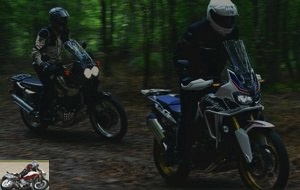
Cycle part
Undoubtedly the strong point of these machines combining balance and performance both in offroad and on asphalt. Designed to get out of the asphalt, the Africa Twins really perform there. Always more efficient, the CRF1000L optimizes these qualities of versatility by bringing more sportiness.
Braking
On the 750, the rear brake surprises with its power when the front lacks bite, especially on the road. Powerful and enduring, the system of the 1000 does not lack progressiveness, both front and rear. Modulated or energetic, taking the brakes delivers exactly the desired result. ABS is also very satisfactory.
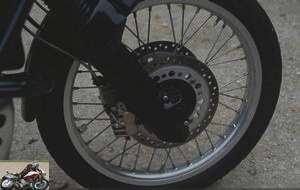
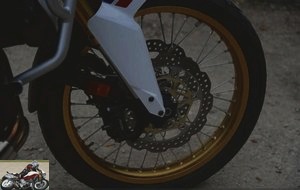
Comfort / Duo
The XRV’s saddle, narrow and firm, will not entice a passenger to accompany you to the end of the world. Soft seats and quality suspensions contribute to the remarkable comfort of the Africa Twin 2016. With its generous grab handles surrounding a welcoming saddle, the accompanying person enjoys good comfort. Only regret, the footrests of the accompanying person are not sheathed.

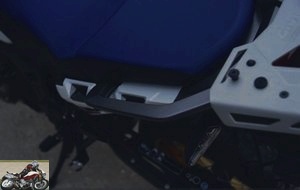
Consumption
The 23 liters of the XRV750 allow stages of nearly 400 km, with an average of 6 L / 100 km. Less bulky and serving as a more invigorating boiler, the CRF1000L bottle provides at least 300 km of autonomy with the same thirst for unleaded.
To watch on the XRV750 model
- Fragile fuel pump (carbon brushes). Many ride a Facet pump.
- The trip master is very often out of date on motorcycles with experience
- The gearbox output shaft wears out (check that the pinion has not been welded on !!!)
Conclusion
The confrontation of the two generations makes it possible to measure the reasoned and faithful optimization brought to the original Africa Twin. Efficient both in mechanics and in cycle parts, the novelty transcends the legendary capacities of its ancestor. The testing machines belong to the same owner who, after a few weeks of driving the new one, finally separates from the old one. Best of all, the CRF1000L has only one thing left to prove: the reliability of its new engine. Indestructible, the V-twin and the build quality of the XRV750 still make its reputation. To realize this, it suffices to see the side of a machine in good condition. Sold for € 9,000 at the time, the most beautiful are still trading at € 4,000 without discussing.
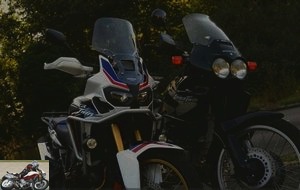
Efficient, dynamic, attractive, the Honda CRF1000L Africa Twin sublimates its predecessor. Its electronic assistance and an automatic gearbox version further optimize its approval. The novelty is placed at the highest level of general performance compared to comparable machines. It is now asking € 12,999 (€ 13,299 for the Replica version and € 1,000 more for the DCT versions). A rather competitive price in a well-supplied market to perpetuate the Africa saga.
Strong points
- Engine character at mid and high revs
- Agility and precision of the cycle part
- All-terrain efficiency
- Ergonomics
- Electronic assistance
- Braking
- Quality suspension
- Sound
Weak points
- No central stand as standard
- Tank capacity a little tight for backpackers
Honda CRF1000L Africa Twin technical sheet
Related articles
-
Honda Africa Twin CRF1000L test
Honda CRF1000L Africa Twin ABS and DCT version Legends never die. Like the phoenix, the Africa Twin is reborn from the sand of its past exploits in a…
-
Comparo Honda CRF1100L Africa Twin and Adventure Sports
Two Africa Twin 1100 for the price of one! or the opposite ? Angry backpackers After a masterful comeback in 2016, the Honda Africa Twin CRF1000L…
-
Honda Africa Twin test in the mud
Three levels of traction control, disconnectable ABS, DCT: useful, or not ? A life-size test at the Honda Adventure Center in Wales A real commercial…
-
Comparo Honda X-ADV / Africa Twin
Vendetta Sino-Corsica With two flagship models, Honda returns to adventure and versatility. Both the return of the legendary CRF1000L Africa Twin and the…
-
Honda Africa Twin CRF1100L Adventure Sports motorcycle test
100 hp, 105 Nm at 6,250 rpm, 238 kg all full (250 kg in DCT / EERA), 16,899 euros (19,399 euros in DCT and EERA suspensions). The spirit is there It…
-
Motorcycle comparison BMW 1250 GS / Honda Africa Twin 1100
Potato or mash ? BMW R 1250 GS 136 hp, 143 Nm at 6250 rpm, 249 kg all full, 17,600 euros (21,294 euros for the model tested with Comfort, Dynamic and…
-
Some subtle changes for the 2018 version of the trail In-line twin, 998 cm3, 95 hp at 7,500 rpm, 98 Nm at 6,000 rpm, from 237 kilos, from 13,549 € The…
-
Honda Africa Twin Adventure Sports test
Honda returns to the adventurous spirit of the original Africa Twins In-line twin, 998 cm3, 95 hp at 7,500 rpm, 98 Nm at 6,000 rpm, from 243 kilos, from…
-
Comparative test DN 01, XL700V Transalp ABS-CBS, NT700V Deauville ABS CBS What can lead to compare 3 motorcycles as different as a DN 01, an XL700V…
-
Dynamic Ecotrail Since 2011, the NC700 family has been trying to respond, each according to their specificities in the daily life of mostly peri-urban…
… and yet … what a machine !
The banana in all circumstances: easy, practical, comfortable, torquey, well finished, racy…
I hesitated [Strasbourg;)] and finally the only ones who stopped me are the curious sympathizers. To change the image we have of it, we should no longer leave the exclusivity of this bike to the only thugs…
A good hearer .. See you all!
Of course, I should have specified " simpleS treeS with cams". It may seem obvious.
Clearly, per cylinder: one ACT and three valves. In all 2 ACT and 6 valves.
The count is right.
Rahlalala…
It’s not like Froggy knows a thing or two about mechanics. Am sure you understood very well, rascal pitit.
Really what a filthy bathtub, I do not see the interest of this kind of stuff …
I love the lair for its exhaustive and uncompromising testing. It’s kind of your hallmark that old-fashioned look. The annoying thing in this role of guardian of the temple is the reactive side that it entails and that we often find in the comments.